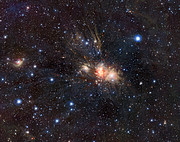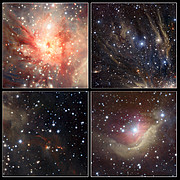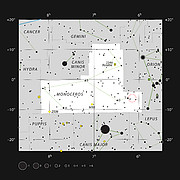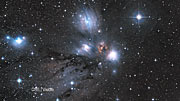Lehdistötiedote
VISTA paljastaa Yksisarvisen salaisuuden
6. lokakuuta 2010

Acknowledgment: Cambridge Astronomical Survey Unit)
ESOn VISTA-kartoitusteleskoopin uusi infrapunakuva paljastaa hehkuvan kaasun lonkeroiden, pimeiden pilvien ja nuorten tähtien epätavallisen maiseman Yksisarvisen (Monoceros) tähdistössä.
Tämä nimellä Monoceros R2 tunnettu tähtien syntyalue on suunnattoman suuren pimeän sumun sisällä. Näkyvän valon alueella tähtienvälinen pöly peittää alueen näkyvistä lähes kokonaan, mutta infrapunaisessa se on näyttävä kohde.
Aktiivinen tähtien lastentarha Yksisarvisen tähdistössä kätkeytyy massiiviseen pimeään sumuun, jossa on runsaasti molekyylejä ja pölyä. Vaikka se näkyy taivaalla tutumman Orionin sumun lähellä, se on
todellisuudessa lähes kaksi kertaa niin kaukana Maasta, noin 2700 valovuoden etäisyydellä. Näkyvässä valossa massiivisten kuumien tähtien ryhmittymä tuottaa joukon kauniita heijastussumuja, joissa
sinertävä tähtien valo siroaa molekyylipilvien pimeistä, sumuisista ulkokerroksista. Useimmat vastasyntyneistä massiivista tähdistä ovat kuitenkin piilossa, sillä paksu tähtienvälisen pölyn kerros absorboi tehokkaasti niiden ultraviolettia ja näkyvää valoa.
Tässä komeassa kuvassa ESOn Pohjois-Chilen Paranalin observatorion VISTA-teleskooppi (Visible and Infrared Survey Telescope for Astronomy [1], eso0949) tunkeutuu pimeän pölyverhon läpi ja tuo esiin
hämmästyttävän tarkasti tähtienvälisen aineen poimut, silmukat ja säikeet, joita kuumien nuorten tähtien voimakas tähtituuli ja säteily ovat muovanneet.
VISTA-konsortion Jim Emerson Lontoon yliopistosta kertoo: "Nähdessäni tämän kuvan ensi kertaa sanoin vain 'Vau!'. Hämmästyin, kun näin niin selvästi kaikki pölyvanat Monoceros R2 -joukon ympärillä samoin kuin suihkut syvällä pilven sisällä olevista tähdistä. Näissä VISTAn kuvissa on niin paljon jännittäviä yksityiskohtia."
Laajan näkökenttänsä, suuren peilinsä ja herkän kameransa ansiosta VISTA on ihanteellinen havaintoväline tuottamaan korkeatasoisia infrapunakuvia suurista taivaan alueista, kuten Monoceros R2:n
alueesta. VISTAn näkökenttä vastaa tällä etäisyydellä noin 80 valovuotta. Koska pöly on hyvin läpinäkyvää infrapuna-alueella, näkyviin saadaan monia nuoria tähtiä, jotka eivät erotu näkyvän valon kuvissa. Näistä kaikkein massiivisimmat tähdet ovat alle kymmenen miljoonan vuoden ikäisiä.
Kuva on yhdistetty valotuksista, jotka on otettu spektrin lähi-infrapunaisen kolmella eri aallonpituusalueella. Monoceros R2:n kaltaisten molekyylipilvien matalassa lämpötilassa
ja suhteellisen korkeassa tiheydessä voi syntyä vety- ja muita molekyylejä, jotka sopivissa olosuhteissa säteilevät voimakkaasti lähi-infrapunaisessa. Monet VISTAn kuvassa vaaleanpunaisina ja punaisina näkyvät muodostumat ovat todennäköisesti nuorista tähdistä virtaavan molekulaarisen
vedyn hehkua.
Monoceros R2:lla on tiheä korkeintaan kahden valovuoden läpimittainen ydin, joka on täynnä hyvin massiivisia nuoria tähtiä. Siellä on myös joukko kirkkaita infrapunalähteitä, jotka ovat tyypillisesti
vielä pölyisten kiekkojen ympäröimiä vastasyntyneitä massiivisia tähtiä. Tämä alue on kuvan keskellä, jossa tarkemmin tutkittaessa näkyy paljon tiheämpi tähtien keskittymä ja jonka selvät punertavat piirteet
viittavat todennäköisesti molekulaarisen vedyn säteilyyn.
Oikeanpuoleisin kuvan keskellä olevista kirkkaista pilvistä on tämän alueen kirkkain heijastussumu NGC 2170. Näkyvässä valossa sumu näkyy kirkkaana vaaleansinisenä saarena tumman meren keskellä,
kun taas infrapunakuva tuo näkyviin sumujen sisällä olevat raivoisat tehtaat, joissa syntyy sadoittain massiivisia tähtiä. NGC 2170 erottuu heikosti pienellä kaukoputkella, ja sen löysi
William Herschel Englannissa vuonna 1784.
Tähdet syntyvät prosesseissa, jotka tyypillisesti kestävät muutamia miljoonia vuosia, ja joita tapahtuu suurten, satojen valovuosien läpimittaisten tähtienvälisen aineen kaasu- ja pölypilvien sisällä.
Koska näkyvä valo ei pääse tähtienvälisen pölyn läpi, infrapuna- ja radiohavainnot ovat ratkaisevan tärkeitä yrittäessämme ymmärtää tähtien kehityksen varhaisimpia vaiheita. VISTA kartoittaa systemaattisesti etelätaivasta ja tuottaa noin 300 gigatavua havaintoaineistoa yössä, mikä tarjoaa
valtavan määrän tietoa alueista, joita tutkivat yksityiskohtaisemmin VLT (Very Large Telescope), ALMA (Atacama Large Millimeter/submillimeter Array) ja tulevaisuudessa E-ELT (European Extremely Large Telescope).
Lisähuomiot
[1] 4,1-metrisen pääpeilinsä ansiosta VISTA on maailman suurin kartoituskaukoputki, ja sen 67 miljoonan pikselin infrapunakamera on suurempi kuin missään muussa kaukoputkessa. Se on varattu taivaan kartoitukseen, joka alkoi 2010. Se sijaitsee Pohjois-Chilessä Atacaman autiomaassa ESOn VLT:n sijoituspaikan Cerro Paranalin viereisellä huipulla, joten sillä on samanlaiset erinomaiset havainto-olosuhteet. Atacaman autiomaa on maapallon kuivimpia paikkoja, ja taivas näkyy erityisen hyvin. Siksi vain 20 km:n päässä Cerro Paranalista sijaitseva Cerro Armazones on äskettäin valittu tulevan E-ELT:n sijoituspaikaksi.
Lisätietoa
ESO (European Southern Observatory; Euroopan eteläinen observatorio) on Euroopan johtava kansainvälinen tähtitieteellinen organisaatio ja maailman tuotteliain tähtitieteellinen observatorio.
Siinä on osallisina 14 maata:
Belgia, Englanti, Espanja, Hollanti, Italia, Itävalta, Portugali, Ranska, Ruotsi, Saksa, Suomi, Sveitsi, Tanska ja Tsekki. ESOlla on kunnianhimoinen ohjelma, joka keskittyy sellaisten maanpäällisten havaintolaitteiden suunnitteluun, rakentamiseen ja käyttöön, joiden avulla tähtitieteilijät voivat tehdä tärkeitä tieteellisiä keksintöjä. ESOlla on myös johtava asema tähtitieteen yhteistyön tukijana ja organisoijana. ESO ylläpitää Chilessä kolmea ainutlaatuista huippuluokan havaintopaikkaa: La Silla, Paranal ja Chajnantor. Paranalilla ESOlla on VLT, maailman edistyksellisin näkyvän valon tähtitieteellinen observatorio, ja VISTA, maailman suurin kartoitusteleskooppi. ESO on eurooppalainen osakas mullistavassa ALMA-teleskoopissa, joka on tämän hetken suurin tähtitieteellinen projekti. Parhaillaan ESO suunnittelee 42 metrin näkyvän valon ja lähi-infrapuna-alueen E-ELT-teleskooppia (European Extremely Large Telescope), josta tulee maailman suurin
taivaalle katsova silmä.
Linkit
Yhteystiedot
Richard Hook
ESO, Paranal, La Silla, E-ELT and Survey Telescopes Public Information Officer
Garching bei München, Germany
Puh.: +49 89 3200 6655
Sähköposti: rhook@eso.org
Pasi Nurmi (Lehdistön yhteyshenkilö Suomi)
ESO Science Outreach Network
ja University of Turku
Turku, Finland
Puh.: +358 29 4504 358
Sähköposti: eson-finland@eso.org
Tiedotteesta
| Tiedote nr.: | eso1039fi |
| Nimi: | Monoceros R2 |
| Tyyppi: | Milky Way : Nebula : Type : Star Formation |
| Facility: | Visible and Infrared Survey Telescope for Astronomy |
| Instruments: | VIRCAM |
Our use of Cookies
We use cookies that are essential for accessing our websites and using our services. We also use cookies to analyse, measure and improve our websites’ performance, to enable content sharing via social media and to display media content hosted on third-party platforms.
ESO Cookies Policy
The European Organisation for Astronomical Research in the Southern Hemisphere (ESO) is the pre-eminent intergovernmental science and technology organisation in astronomy. It carries out an ambitious programme focused on the design, construction and operation of powerful ground-based observing facilities for astronomy.
This Cookies Policy is intended to provide clarity by outlining the cookies used on the ESO public websites, their functions, the options you have for controlling them, and the ways you can contact us for additional details.
What are cookies?
Cookies are small pieces of data stored on your device by websites you visit. They serve various purposes, such as remembering login credentials and preferences and enhance your browsing experience.
Categories of cookies we use
Essential cookies (always active): These cookies are strictly necessary for the proper functioning of our website. Without these cookies, the website cannot operate correctly, and certain services, such as logging in or accessing secure areas, may not be available; because they are essential for the website’s operation, they cannot be disabled.
Functional Cookies: These cookies enhance your browsing experience by enabling additional features and personalization, such as remembering your preferences and settings. While not strictly necessary for the website to function, they improve usability and convenience; these cookies are only placed if you provide your consent.
Analytics cookies: These cookies collect information about how visitors interact with our website, such as which pages are visited most often and how users navigate the site. This data helps us improve website performance, optimize content, and enhance the user experience; these cookies are only placed if you provide your consent. We use the following analytics cookies.
Matomo Cookies:
This website uses Matomo (formerly Piwik), an open source software which enables the statistical analysis of website visits. Matomo uses cookies (text files) which are saved on your computer and which allow us to analyze how you use our website. The website user information generated by the cookies will only be saved on the servers of our IT Department. We use this information to analyze www.eso.org visits and to prepare reports on website activities. These data will not be disclosed to third parties.
On behalf of ESO, Matomo will use this information for the purpose of evaluating your use of the website, compiling reports on website activity and providing other services relating to website activity and internet usage.
Matomo cookies settings:
Additional Third-party cookies on ESO websites: some of our pages display content from external providers, e.g. YouTube.
Such third-party services are outside of ESO control and may, at any time, change their terms of service, use of cookies, etc.
YouTube: Some videos on the ESO website are embedded from ESO’s official YouTube channel. We have enabled YouTube’s privacy-enhanced mode, meaning that no cookies are set unless the user actively clicks on the video to play it. Additionally, in this mode, YouTube does not store any personally identifiable cookie data for embedded video playbacks. For more details, please refer to YouTube’s embedding videos information page.
Cookies can also be classified based on the following elements.
Regarding the domain, there are:
- First-party cookies, set by the website you are currently visiting. They are stored by the same domain that you are browsing and are used to enhance your experience on that site;
- Third-party cookies, set by a domain other than the one you are currently visiting.
As for their duration, cookies can be:
- Browser-session cookies, which are deleted when the user closes the browser;
- Stored cookies, which stay on the user's device for a predetermined period of time.
How to manage cookies
Cookie settings: You can modify your cookie choices for the ESO webpages at any time by clicking on the link Cookie settings at the bottom of any page.
In your browser: If you wish to delete cookies or instruct your browser to delete or block cookies by default, please visit the help pages of your browser:
Please be aware that if you delete or decline cookies, certain functionalities of our website may be not be available and your browsing experience may be affected.
You can set most browsers to prevent any cookies being placed on your device, but you may then have to manually adjust some preferences every time you visit a site/page. And some services and functionalities may not work properly at all (e.g. profile logging-in, shop check out).
Updates to the ESO Cookies Policy
The ESO Cookies Policy may be subject to future updates, which will be made available on this page.
Additional information
For any queries related to cookies, please contact: pdprATesoDOTorg.
As ESO public webpages are managed by our Department of Communication, your questions will be dealt with the support of the said Department.







